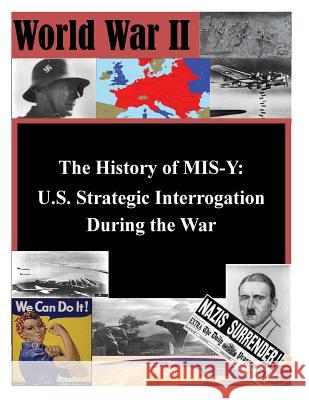The History of MIS-Y: U.S. Strategic Interrogation During the War » książka
The History of MIS-Y: U.S. Strategic Interrogation During the War
ISBN-13: 9781500382230 / Angielski / Miękka / 2014 / 156 str.
Behind the combat operations of World War II, Allied and Axis intelligence services were locked in an impassioned effort to generate the critical advantage intelligence could provide. More than fifty years later, historians continue to piece together details on the array of intelligence activities pursued on both sides that supported the policymaker and battlefield commander alike. While the impressive accomplishments achieved by signals intelligence programs such as ULTRA and the daring human intelligence operations conducted by the famed Office of Strategic Services have garnered the lion's share of both publicity and academic research, the role of prisoner-of-war (POW) interrogation has remained largely unexplored territory. As World War II unfolded, the strategic interrogation programs established by the British, German, and American forces evolved into robust collection entities that proved to be a unique source of critical intelligence. Decades after their closure, the spate of academic research into these programs has only recently begun to be addressed. Whereas researchers have made headway in chronicling the British and German programs, relatively little has been written about the U.S. program in operation during the same period. Using recently declassified material from the National Archives and Record Administration, this thesis seeks to capture the essence of the strategic interrogation program conducted under the auspices of the War Department's Military Intelligence Service (code-named MIS-Y) with the mission of bringing selected German POWs from the European Theater of Operations to the U.S. for the purpose of gathering vital intelligence in support of the Allied war effort. This study examines the key elements of MIS-Y, to include the events that led to its founding; the program's organization and facilities; the training it provided for its interrogation and operational support personnel; its methods for screening and selecting high value POWs; its process for interrogation and exploitation of captured documents; the Allied intelligence requirements that drove its operations; and the nature of the intelligence it produced and disseminated. A primary objective of this thesis is to add to the Intelligence Community's body of knowledge about the challenges and opportunities inherent in the strategic interrogation of POWs. It will also search this event in contemporary military history for timeless principles in the conduct of strategic level interrogation operations-principles that would guide a more effective intelligence program in support of future military operations. The work begins with a brief overview of the nature and history of intelligence. It then demonstrates how the successful POW intelligence program conducted by the British War Office influenced the development of a similar program in the U.S. The study continues by providing detailed insights into the inter-service struggle to develop a strategic interrogation program, including the selection of Fort Hunt, a Civil War-era military camp, as the site for building and operating a Joint Interrogation Center. Finally, this work chronicles the unique training designed to prepare MIS-Y personnel for their duties and the systematic methodology for screening, selecting, handling, monitoring, and interrogating the thousands of high value German POWs that transited Fort Hunt from 1942-1945.
Zawartość książki może nie spełniać oczekiwań – reklamacje nie obejmują treści, która mogła nie być redakcyjnie ani merytorycznie opracowana.











